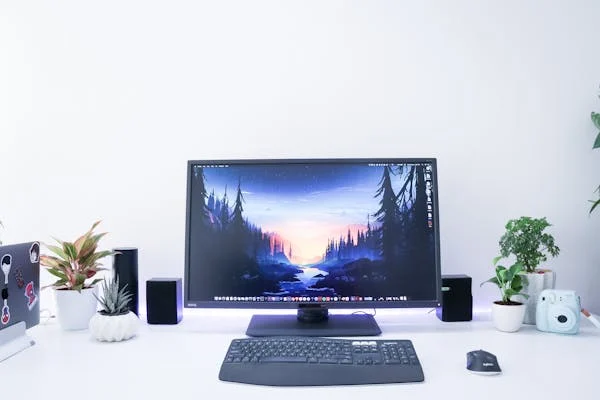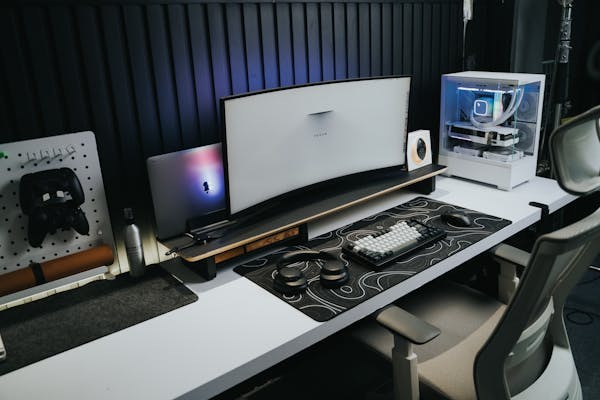
Table of Contents
ToggleProductivity-Boosting Ergonomic Furniture for Home Office: 7 Essential Pieces You Need for Success
When working from home, your office setup is crucial for both your comfort and productivity. Poorly designed furniture can lead to fatigue, poor posture, and difficulty focusing. Investing in ergonomic furniture like ergonomic chairs, height-adjustable desks, and ergonomic accessories can significantly reduce physical strain, helping you maintain comfort throughout the day. This is essential for staying focused and productive, especially during long hours of work.
By optimizing your workspace with ergonomic furniture, you ensure that your body is properly supported, reducing the risk of long-term health issues such as back pain or eye strain. These adjustments not only enhance physical well-being but also boost mental clarity, allowing you to stay energized and focused. With the right ergonomic office setup, you’ll experience greater work efficiency and overall productivity.
Why Ergonomics Matter in a Home Office
Ergonomics is not just a trend—it’s essential for optimizing your health and productivity, especially in a home office environment. Spending long hours sitting at an improperly designed desk can lead to back pain, poor posture, and decreased focus. Investing in ergonomic office furniture, like ergonomic chairs, adjustable desks, and keyboard trays, can make a significant difference. These ergonomic solutions ensure that your body is properly supported, reducing strain and enhancing comfort, which in turn leads to better concentration and more efficient work. Prioritizing ergonomics in your home office is one of the most effective ways to stay productive and maintain well-being while working from home.
The Impact on Physical Health
Long hours spent at a desk without the right ergonomic furniture can lead to a range of physical issues, from back pain and neck strain to poor posture and even long-term injuries. An improperly set up workspace can strain muscles, joints, and ligaments. Ergonomic office furniture addresses these concerns by supporting the body’s natural alignment, encouraging proper posture. An ergonomic chair with lumbar support helps prevent lower back pain by supporting the spine’s natural curve. Additionally, an adjustable desk allows you to alternate between sitting and standing, reducing the risk of stiffness in your legs and lower back. Simple changes like these can make a huge difference in your daily comfort and long-term physical health.

Enhancing Mental Focus and Productivity
Comfort plays a vital role in mental focus and productivity. Discomfort can be distracting and lead to decreased concentration, resulting in less effective work. Ergonomic furniture promotes better posture by ensuring that your desk, chair, and other accessories are properly adjusted to fit your body. By reducing physical strain, such as neck pain or wrist fatigue, you can stay focused for longer periods without needing constant breaks for discomfort relief. Height-adjustable desks, for example, let you switch between sitting and standing, which helps increase blood flow and energy levels throughout the day. The more comfortable and well-supported you feel, the more productive and focused you’ll become, creating a more efficient work environment.
Key Features of Ergonomic Furniture
When selecting ergonomic furniture for your home office, it’s important to understand the essential features that contribute to comfort and productivity. Not all ergonomic solutions are the same—choosing the right pieces will ensure long-term health benefits and improved efficiency during your workday.
Adjustability
Adjustability is one of the core features of ergonomic furniture. Everyone has a different body type, so having adjustable elements allows you to tailor your furniture for maximum comfort and support. Ergonomic chairs with adjustable seat heights, backrest angles, and armrest positions are essential for maintaining proper posture and reducing strain on your muscles and joints. Likewise, height-adjustable desks are key to alternating between sitting and standing positions, which helps to alleviate pressure on your lower back and legs. This flexibility not only enhances comfort but also improves overall work productivity, allowing for a more dynamic work environment.
For example, the ability to change the desk height helps reduce the strain caused by long periods of sitting, potentially lowering your risk for musculoskeletal disorders and enhancing your focus. Regularly switching between sitting and standing positions is proven to promote blood circulation, increasing energy and productivity.
Support for Proper Posture
Proper posture is essential for avoiding discomfort and long-term health issues, especially when working long hours from home. Ergonomic furniture is specifically designed to promote good posture. For instance, ergonomic chairs with lumbar support ensure that the natural curve of your spine is maintained, preventing lower back pain. Chairs with adjustable armrests help reduce shoulder strain by ensuring your arms are positioned at the correct height, avoiding discomfort and muscle fatigue.
Additionally, ergonomic furniture like footrests and keyboard trays help align your body at the optimal angle for typing and working. These tools help prevent strain in your wrists, shoulders, and neck, further supporting healthy ergonomics. With these features, you’ll not only feel better physically but will be able to work for longer periods without experiencing the discomfort that often leads to breaks or decreased productivity.
Material and Design Considerations
The materials and design of ergonomic furniture also play an essential role in comfort, durability, and overall user experience. Look for breathable fabrics that allow for better air circulation, especially in ergonomic chairs, as this will help maintain comfort even during long hours. Memory foam cushioning is another key feature, providing a customized fit to your body and enhancing support. High-quality materials like sturdy metals and durable plastics contribute to the longevity of the furniture, making it a worthwhile investment.
The design of ergonomic furniture should also consider your workspace’s aesthetic, ensuring the pieces not only offer functionality but also blend seamlessly with your home office décor. Investing in high-quality, well-designed ergonomic pieces improves comfort and provides lasting support, reducing the likelihood of needing to replace your furniture over time.
Top Ergonomic Furniture Options for a Home Office
Now that we’ve covered the key features of ergonomic furniture, let’s explore some of the top ergonomic furniture options that can transform your home office setup. These pieces not only enhance comfort but also help improve your productivity by promoting better posture and reducing physical strain.

Ergonomic Office Chairs
A comfortable ergonomic office chair is crucial for creating a workspace that promotes good posture and reduces strain during long hours of sitting. When selecting an ergonomic chair, look for key features such as lumbar support, seat height adjustability, and adjustable armrests. Proper lumbar support helps maintain the natural curve of your spine, preventing lower back pain, while seat height adjustments ensure your feet are flat on the floor for better circulation. The chair’s material should be breathable, such as mesh fabric, to prevent heat buildup and discomfort.
High-quality ergonomic chairs like the Herman Miller Aeron and Steelcase Leap are ideal for those who work long hours at their desks. The Aeron Chair is famous for its PostureFit SL support system, which keeps your spine aligned and reduces back tension. Its adjustable arms and seat depth allow for personalized comfort. The Steelcase Leap is equally praised for its LiveBack technology, which adjusts to your spine’s movements throughout the day. These chairs provide flexible and customizable support, ensuring long-term comfort and reducing the risk of musculoskeletal problems.
Best Ergonomic Chairs for Long Hours
Spending extended hours at your desk can be draining on both your body and mind, which is why choosing the right ergonomic chair is vital. The Herman Miller Aeron excels for long hours of use due to its breathable mesh material and adjustable tilt mechanisms, which help reduce pressure on the lower back. Its design is focused on comfort, promoting proper posture and eliminating discomfort. The Steelcase Leap also stands out due to its adjustable lumbar support and flexible backrest, which provide tailored support to your back, minimizing strain during extended periods of sitting.
Additionally, both chairs are equipped with adjustable armrests that allow for optimal forearm support, which helps alleviate shoulder and neck strain. These ergonomic features are particularly helpful for those who experience discomfort or stiffness during long work sessions. With both of these chairs, you can customize each feature to suit your body’s specific needs, ensuring that you stay comfortable and productive throughout the day.
Height-Adjustable Desks
Sitting for long periods can lead to various health issues such as lower back pain, poor circulation, and decreased energy. One of the most effective ways to counteract these problems is by using a height-adjustable desk. These desks allow you to easily switch between sitting and standing, promoting better posture and reducing the strain on your back, neck, and shoulders. Alternating between sitting and standing throughout the day helps improve circulation, reduce fatigue, and prevent the discomfort that often arises from prolonged sitting.
Height-adjustable desks come with features like electric or manual height controls, allowing you to find the perfect height for your workstation. This flexibility is especially beneficial for people of different heights and can be adjusted quickly to suit your preference. In addition, standing periodically during the day can boost energy levels, improve focus, and reduce the long-term risks associated with sitting too much. A height-adjustable desk can significantly improve your overall comfort and productivity while maintaining a healthier posture throughout the workday.
Best Sit-Stand Desk Options
When looking for the best sit-stand desks, two popular options are the Uplift V2 Standing Desk and the Fully Jarvis Desk. The Uplift V2 Standing Desk stands out for its smooth electric adjustment system, allowing you to change the desk height with ease, even under heavy loads. Its sturdy frame ensures that the desk remains stable, even when switching between sitting and standing. The Fully Jarvis Desk is another top contender, known for its high stability and quiet motor that offers a seamless height adjustment experience. Its sleek design, coupled with a wide range of customizable options, makes it ideal for those seeking a versatile and ergonomic solution.
Both desks offer a range of sizes and finishes to suit different office setups and styles. These sit-stand desks are designed to reduce the negative effects of sitting for too long while encouraging a more dynamic and comfortable work routine. With adjustable heights, you can alternate between sitting and standing without disrupting your workflow, ultimately enhancing your overall productivity and well-being.
Ergonomic Accessories
To complement your ergonomic chair and desk, incorporating ergonomic accessories such as footrests, keyboard trays, and monitor stands can further enhance your comfort and well-being. A footrest is particularly helpful for individuals who find that their feet don’t rest flat on the floor. It promotes proper leg posture and helps alleviate pressure on the lower back, reducing discomfort during long periods of sitting. Look for footrests that offer adjustable height and a non-slip surface for added support.
A keyboard tray is another essential accessory for achieving an ergonomic setup. It positions your keyboard and mouse at a comfortable height, promoting a neutral wrist position and reducing strain on your arms, shoulders, and wrists. A monitor stand raises your screen to eye level, ensuring that you don’t have to lean forward or strain your neck. This prevents neck and eye strain, which are common issues for those who spend hours working at a computer. By combining these ergonomic accessories with your desk and chair, you create a balanced and healthy workspace that reduces physical strain and enhances productivity.
Top Ergonomic Accessories for Home Offices
While ergonomic furniture forms the foundation of a comfortable home office, adding the right ergonomic accessories enhances comfort and productivity further. Accessories like monitor stands and keyboard trays are essential for creating an optimal workspace that promotes healthy posture and reduces strain.
Monitor Stand: A monitor stand ensures your screen is at eye level, preventing neck strain and maintaining a neutral head position. This simple adjustment helps reduce the risk of neck pain and discomfort, making your workspace more ergonomic-friendly.
Keyboard Tray: An ergonomic keyboard tray allows you to position your keyboard and mouse at the proper height and angle, which helps reduce wrist strain and prevents repetitive stress injuries like carpal tunnel syndrome. With a keyboard tray, your forearms remain parallel to the floor, encouraging healthy posture and minimizing shoulder and wrist discomfort.
VariDesk Pro Plus: The VariDesk Pro Plus is an excellent choice for anyone looking to enhance their ergonomic setup. This accessory provides the flexibility to adjust your monitor and keyboard height, supporting a sit-stand desk setup and allowing you to alternate between sitting and standing, reducing the physical strain of prolonged sitting.
Setting Up an Ergonomically-Friendly Home Office
It’s not just about purchasing ergonomic furniture; the layout and arrangement of your office furniture play a significant role in maximizing your comfort and productivity. A well-organized workspace can promote ergonomics and help you stay focused throughout your workday.

Workspace Layout and Furniture Arrangement
When arranging your home office, make sure your desk allows you to maintain a neutral spine position. Your feet should rest flat on the floor, and your arms should remain comfortably at a 90-degree angle when typing or using a mouse. Ergonomic furniture such as height-adjustable desks can help you customize your setup, ensuring that your workstation promotes good posture, ultimately reducing strain.
Lighting and Screen Placement
Proper lighting is key to preventing eye strain and maintaining focus, especially when working long hours. Use natural light where possible, or incorporate adjustable desk lamps with a softer, non-glare lighting option. Avoid positioning your desk directly in front of a window, as direct sunlight can cause glare on your screen. Ensure that your screen is at a comfortable distance to reduce the urge to lean forward, which can lead to neck and back strain.
Optimal Screen Height and Distance
Positioning your monitor correctly is vital for ergonomics. Your monitor should be at eye level, ensuring that the top of the screen is roughly in line with your natural line of sight. Ideally, the screen should be 20-30 inches from your eyes, with a slight tilt to reduce glare. Maintaining this optimal screen height and distance prevents neck strain and helps you maintain a neutral head position.
Maintaining Ergonomics Throughout the Workday
Once you’ve set up your ergonomic office furniture, it’s important to maintain good posture and take regular breaks throughout the workday. This ensures that your home office ergonomics are effective in preventing discomfort and increasing productivity.
Regular Movement and Breaks
Even with the best ergonomic furniture setup, sitting for extended periods can still result in muscle stiffness and discomfort. Taking short breaks every 30-60 minutes to stand up, stretch, or take a quick walk around your home can help keep your muscles relaxed and improve circulation. Incorporating these movements into your routine helps boost productivity and reduces fatigue.
Adjusting Furniture for Different Tasks
Different tasks may require slight adjustments to your ergonomic furniture setup. For instance, if you’re typing, you may need your desk to be lower to keep your arms at a 90-degree angle. For reading or writing, adjust the height of your chair or desk to maintain comfort and reduce strain. Flexibility is key in ensuring that your workspace remains ergonomic throughout the day, depending on the task at hand.
Conclusion
Productivity-Boosting ergonomic furniture for home office isn’t just about comfort—it’s about making intelligent choices that improve your health and efficiency. Investing in ergonomic office chairs, height-adjustable desks, and ergonomic accessories can transform your workspace into a hub of comfort and focus. These pieces not only reduce discomfort and promote proper posture but also enhance mental clarity and long-term productivity. Optimizing your home office with ergonomic furniture will keep you energized and more productive throughout the day. For more ways to boost work-from-home productivity, visit Remote Worker Ergonomics.
FAQs
1. What is ergonomic furniture?
Ergonomic furniture is designed to support your body in a way that promotes proper posture and reduces strain on your muscles and joints. It’s built to enhance comfort, productivity, and well-being.
2. How does ergonomic furniture improve productivity?
By providing comfort and promoting proper posture, ergonomic furniture helps reduce discomfort, allowing you to stay focused and work for longer periods without physical distractions.
3. Can ergonomic furniture help with back pain?
Yes! Ergonomic chairs with lumbar support help maintain the natural curve of your spine, reducing back pain and preventing further injury.
4. What are the best ergonomic office chairs for long hours?
Top ergonomic office chairs for long hours include the Herman Miller Aeron, Steelcase Leap, and Secretlab Titan. These chairs provide excellent support for extended sitting.
5. Are sit-stand desks really beneficial?
Yes! Sit-stand desks help reduce the negative effects of sitting for long periods, such as back pain and poor circulation, by allowing you to alternate between sitting and standing.
6. How do I adjust my desk and chair for optimal ergonomics?
Adjust your chair so that your feet are flat on the floor, with your knees at a 90-degree angle. Your desk height should allow your arms to rest comfortably at a 90-degree angle while typing.
7. What accessories can I use to make my home office more ergonomic?
Some great ergonomic accessories include footrests, keyboard trays, monitor stands, and mouse pads with wrist support. These help improve posture and comfort throughout the day.
8. How often should I take breaks when working from home?
It’s recommended to take a break every 30-60 minutes. Stand up, stretch, or walk around to keep your muscles relaxed and your mind fresh.

